Fashion Forward: Embracing the 7 R's of Sustainable Style

Sustainable fashion is not just a trend, it's a revolution! In a world where fast fashion reigns, causing considerable harm to our planet and its inhabitants, sustainable fashion emerges as a shining beacon of hope. It's about making fashion choices that are kind to the earth and fair to the people who produce our clothes.
Why is sustainable fashion so crucial today? Well, the fashion industry is one of the largest polluters on the planet. It's responsible for massive water consumption, pollution, and greenhouse gas emissions. Not to mention, it often relies on unethical labour practices. Sustainable fashion counters these issues by prioritising eco-friendly materials, reducing waste, conserving natural resources, and ensuring fair labour practices.
Embracing sustainable fashion means we're not just choosing a garment; we're making a statement. We're saying yes to preserving our environment, yes to ethical working conditions, and yes to a future where fashion and sustainability coexist harmoniously. It's a powerful movement that redefines style with a conscience, urging us to think before we buy and choose quality over quantity. In a world facing environmental crises and social injustices, sustainable fashion is not just important, it's essential. It's about looking great and feeling even better, knowing our fashion choices are making a positive impact on the world.
Sustainable fashion is not just a trend; it's a revolution. In a world where fashion is one of the largest polluters, sustainable fashion emerges as the knight in shining armour. It's about creating clothing that considers both environmental and socio-economic aspects. This means engaging in eco-friendly practices and ensuring fair wages and working conditions for workers. Why is this important? Well, the planet is screaming for help, and the fashion industry, being a major player, has the power to make a significant positive impact. Sustainable fashion is about wearing your values on your sleeve – quite literally!
Now, let's dive into the core of this revolution – the 7 R's of sustainable fashion:
- Rethink: This is the starting point. Rethinking involves questioning your fashion choices. Do you really need that new dress or are you following a fleeting trend? It's about changing your mindset to value quality over quantity.
- Reduce: Less is more! Reducing means buying fewer items of higher quality. It's about breaking free from the fast fashion cycle and choosing pieces that last longer.
- Reuse: Bring out the stylist in you! Reusing clothes is all about finding new ways to wear old clothes. It can be as simple as mixing and matching different pieces or getting creative with alterations.
- Repair: Don’t throw, sew! Repairing clothes extends their life and keeps them out of landfills. Learning basic sewing skills can be incredibly empowering and environmentally friendly.
- Rent: Why buy when you can rent? Renting clothes, especially for occasions, is a great way to indulge in variety without burdening the planet.
- Recycle: Old can be gold. Recycling involves turning old clothes into new ones. It’s a wonderful way to reduce waste and give clothes a second life.
- Resell: Give your clothes a new home! Reselling not only earns you some money back but also ensures that the clothes are used to their fullest potential.
By embracing these 7 R's, we can collectively stride towards a more sustainable and fashionable future. It's not just about looking good but also about feeling good, knowing that your fashion choices are helping to heal the planet.

RETHINK.
Step into the world of sustainable fashion, where the first step is a mental makeover: Rethink. This is where your journey to becoming a fashion-forward eco-warrior begins. Rethinking is the art of challenging your own fashion choices and motives. It's a call to pause and ponder before you purchase.
Why is Rethinking so crucial? It's simple: every fashion choice has a story and an impact. When you rethink, you're not just choosing a garment; you're choosing the story you want to support. It's about considering the 'why' before the 'buy'. Do you need that new outfit, or are you being swayed by a passing trend? Rethinking encourages us to shift from impulsive shopping to intentional buying.
Let's paint a picture with some examples:
- Capsule Wardrobe: Imagine having a wardrobe where every piece is something you love and wear regularly. A capsule wardrobe is about curating a limited selection of versatile and timeless pieces that can be mixed and matched to create numerous outfits. It’s sustainable, stylish, and simplifies your life!
- Mindful Purchases: Next time you're tempted by a sale, ask yourself: "Will I wear this at least 30 times?" If the answer is no, you probably don’t need it. This mindset helps in reducing waste and promoting the purchase of high-quality, long-lasting items.
- Understanding the Impact: Rethink by educating yourself about the environmental and social impact of your clothes. Who made them? What materials are used? What is the carbon footprint? Knowledge is power, and in this case, it’s the power to choose ethically made and eco-friendly products.
- Supporting Sustainable Brands: Part of rethinking is choosing to support brands that prioritize sustainability. Look for labels that use eco-friendly materials, ensure fair labour practices, and have transparent supply chains.
In essence, Rethink isn’t just about changing what you buy; it’s about changing how you think about what you wear. It's a powerful first step in a journey towards a more sustainable and conscious approach to fashion. Remember, every sustainable choice, no matter how small, makes a difference. It's time to wear your values, and it all starts in the mind!
Rethink:
- Challenge: Overcoming habitual consumerism and the allure of fast fashion trends.
- Addressing: Education and awareness campaigns can help shift consumer mindsets. Encouraging thoughtfulness in purchases and promoting the long-term benefits of sustainable choices can gradually change habits.
Having reshaped our mindset with 'Rethink', we naturally progress to 'Reduce', where the conscious decision to minimise our wardrobe becomes a stylish statement of sustainability.

REDUCE.
Welcome to the world of "Reduce" in sustainable fashion, where less truly becomes more. In this chapter of our eco-chic saga, we're talking about reducing consumption – a powerful move that benefits both your wardrobe and the planet.
Why is reducing consumption a game changer? It's all about impact. The fashion industry is infamous for its high carbon footprint, water usage, and waste production. By buying less, you're directly cutting down on these environmental harms. Plus, reducing consumption means less clutter in your life and more appreciation for what you own.
Now, let's dive into some practical tips for the conscious consumer:
- Quality Over Quantity: Invest in high-quality pieces that last longer. Yes, they might cost more upfront, but they won’t need replacing as often. Think of it as a long-term relationship instead of a series of flings with fast fashion.
- Needs vs. Wants: Before buying something new, ask yourself, "Do I need this, or do I just want it?" This simple question can help curb impulsive buys and ensure that your purchases are thoughtful and necessary.
- Versatile Fashion: Opt for versatile pieces that can be styled in multiple ways. This approach maximises your wardrobe’s potential and reduces the need for excessive items.
- Season less Shopping: Embrace season less fashion. Instead of chasing seasonal trends, focus on timeless pieces that work year-round. This way, you're not constantly updating your wardrobe with every changing season.
- Embrace Pre-loved Items: Second-hand shopping is a win-win. It's a sustainable way to add new pieces to your collection while keeping clothes out of landfills. Plus, you never know what unique treasures you might find!
- Care for Your Clothes: Properly caring for your clothes extends their life. Simple actions like washing in cold water, air drying, and following care labels can make a big difference.
- Detox Your Wardrobe: Regularly evaluate your wardrobe. Donate or sell items you no longer wear instead of letting them gather dust. This not only declutters your space but also helps others and the environment.
By adopting a "reduce" mindset, you're not just making a style statement; you're advocating for a more sustainable world. Remember, every small step towards reducing consumption is a leap towards a greener planet. So, next time you shop, think of it as an opportunity to make a positive impact – one chic piece at a time!
Reduce:
- Challenge: The temptation of low-cost, trendy clothing that encourages overconsumption.
- Addressing: Promoting the concept of a capsule wardrobe and the value of investing in fewer, high-quality pieces. Retailers can also play a role by offering durable, timeless designs.
As we embrace the minimalist elegance of 'Reduce', we find ourselves seamlessly stepping into the creative realm of 'Reuse', where the old becomes fashionably new again

REUSE.
Welcome to the realm of Reuse, a fabulous corner in the world of sustainable fashion where your creativity meets eco-consciousness. Reusing isn't just about giving old clothes a second chance; it's about reinventing your wardrobe without adding to the environmental cost. It's a stylish rebellion against the buy-and-throw-away culture!
Why is Reuse a runway hit in sustainable fashion? Because it's all about making the most of what we already have. Every garment reused means one less in the landfill and one less new piece produced, saving precious resources and energy.
Let's strut down the runway of reuse with some creative ideas:
- Upcycling Glam: Transform your old jeans into a chic denim skirt or turn those forgotten scarves into trendy tops. Upcycling is the haute couture of sustainable fashion – it’s all about taking something old and crafting it into something uniquely fabulous.
- Accessory Remix: Got a bunch of old ties? Stitch them together into a quirky handbag. Or take those broken pieces of jewellery and combine them to create a new statement necklace. Accessories are the perfect canvas for your sustainable style statement.
- Swap Till You Drop: Organise or participate in a clothing swap party. It’s like shopping, but better. Swap clothes with friends and refresh your wardrobe without any cost or environmental impact.
- Vintage Vogue: Vintage is not just retro; it's resourceful! Embrace vintage fashion for its uniqueness and sustainability. It’s recycling with a touch of class.
- DIY Décor: Who said fashion is just for wearing? Turn your old clothes into fashionable décor. Use an old sweater to make a cosy pillow cover, or create a vibrant quilt from a collection of old T-shirts.
- Rental Rendezvous: Instead of buying new outfits for every occasion, consider renting them. It’s a fantastic way to keep your look fresh while being kind to the planet.
- Alter to Fit: Sometimes, all a garment needs is a little tweak to become a favourite again. Whether it's hemming a dress or taking in a jacket, alterations can breathe new life into your wardrobe.
By embracing Reuse, you become a fashionista with a mission, turning your closet into a treasure trove of sustainable style. Remember, in the world of sustainable fashion, creativity is your best accessory. Let's make reuse the new black!
Reuse:
- Challenge: Overcoming the stigma associated with wearing pre-owned or old clothes.
- Addressing: Fashion influencers and marketers can help by glamorising the concept of reuse. Workshops on creative ways to style and modify existing clothes can also encourage reuse.
In the spirit of 'Reuse', where we give new life to what we already own, 'Repair' emerges as a natural ally, championing the cause of longevity and love for our cherished garments.

REPAIR.
Welcome to the world of Repair, the unsung hero of sustainable fashion! In an era where disposability is all too common, Repair is like a refreshing breeze of responsibility and resourcefulness. It's about saying no to the throwaway culture and yes to cherishing and revitalising what we already own.
Why is Repair a cornerstone of sustainable fashion? The equation is simple yet profound: Repairing extends the life of your clothes, reducing the need for new production, which in turn saves resources and lessens environmental impact. Every stitch is a stand against waste and an ode to sustainability.
Now, let's thread our way through some inspiring examples of Repair:
- Mending Magic: Got a tear or a hole in your favourite jeans? Turn to the art of mending. From visible mending techniques like sashiko, a Japanese method that turns patches into art, to subtle fixes, mending is both practical and stylish.
- Darning Delight: Darning is not just for socks. This age-old technique can rejuvenate all kinds of garments. It's about weaving threads over a hole, creating a durable and often decorative patch.
- Revamping Shoes: Don't toss those worn-out shoes! Cobblers can work miracles by repairing soles, heels, and other damages, giving your beloved shoes a new lease on life.
- Zipper and Button Fixes: Sometimes, all a garment needs is a new zipper or a replacement button to be good as new. These small repairs can make a big difference in extending a garment's lifespan.
- Tailoring Tweaks: Tailoring isn't just for getting the perfect fit. It can also be used to transform and update the style of a garment. Think turning flared pants into straight-cut or a long dress into a chic midi.
- Knitwear Renewal: Knitwear can be particularly prone to wear and tear. Learning basic knit repair skills can save your cosy sweaters from being discarded.
- Leather Love: Leather goods can last a lifetime if cared for properly. Professional cleaning, conditioning, and repair can revive even the most worn-out leather items.
By embracing Repair, you're not just fixing your clothes; you're weaving a narrative of sustainable living and conscious consumption. It's a stylish statement that says, "I care for my clothes, and I care for the planet." In the end, Repair is more than just a practical skill; it's a fashion philosophy that celebrates longevity, creativity, and sustainability. Let's stitch our way to a greener wardrobe! 🌿👚🧵🪡
Repair:
- Challenge: The declining availability of repair skills and services.
- Addressing: Offering workshops and tutorials on basic repair techniques can empower individuals. Brands could also offer repair services for their products.
Building on the foundation of 'Repair', which teaches us to cherish and mend, we move to the innovative world of 'Repurpose', transforming the ordinary into extraordinary fashion statements.

REPURPOSE.
Welcome to the dazzling world of Repurpose in sustainable fashion, where old clothes get a fabulous second act! Repurposing is all about transformation – taking something that's no longer in use and giving it a brand new purpose. It’s the fashion world's way of saying, “Out with the waste, in with the taste!”
Why is Repurposing a runway star in sustainable fashion? Because it's the ultimate blend of creativity and environmental stewardship. Every repurposed item is a statement against the throwaway culture, a declaration that we can be stylish and sustainable at the same time.
Let's dive into the treasure trove of Repurpose:
- Denim Dreams: Old jeans are a goldmine in the repurpose realm. They're being transformed into everything from trendy tote bags to stylish aprons. The sturdy fabric of denim makes it perfect for a variety of creative projects.
- Sneaker Spin: Athletic shoes are getting a new track in life. Brands are repurposing old sneakers into playground materials, athletic tracks, and even new shoes. It's a leap towards sustainability that's both practical and innovative.
- Banner Bags: Those colourful banners you see at events? They're being turned into unique, durable bags and wallets. It’s an artistic way to give these materials a second, stylish life.
- T-Shirt Twists: The humble T-shirt is being reborn in countless ways – from trendy crop tops to charming quilts. Old T-shirts are also being cut into yarn for knitting or crocheting new items.
- Bridal Bliss: Wedding dresses, often worn just once, are finding new life. They're being dyed and altered into elegant cocktail dresses or repurposed into beautiful christening gowns.
- Scarf Styles: Silk scarves are being transformed into vibrant cushion covers, chic headbands, or even framed as unique wall art.
- Luxury Leftovers: High-end fashion houses are turning their fabric scraps into limited-edition pieces, proving that luxury and sustainability can go hand-in-hand.
Repurposing in fashion isn’t just about being resourceful; it’s about reimagining. It’s about seeing the potential in every item and turning it into something new, stylish, and meaningful. In this world, every old garment is a blank canvas, ready to be transformed into a masterpiece of sustainable style. Let's get creative and repurpose our way to a greener, more fashionable future! 🌿👗✨
Repurpose:
- Challenge: Limited awareness and skills on how to creatively repurpose old clothing.
- Addressing: DIY repurposing tutorials and showcasing success stories can inspire consumers. Fashion education can also incorporate repurposing in its curriculum.
As we revel in the creativity of 'Repurpose', our sustainable fashion journey leads us to 'Recycle', where the transformation of materials takes our commitment to the environment full circle.

RECYCLING.
Step into the eco-chic world of Recycling in fashion, where old garments get a runway-worthy makeover! Recycling in the fashion industry is like a phoenix rising from the ashes - it’s about transforming discarded fabrics and materials into stunning new pieces. It's not just a trend; it's a movement towards a greener, more glamorous future.
Why is Recycling turning heads in fashion? Because it tackles one of the industry's biggest problems - waste. With tons of textiles ending up in landfills each year, recycling is the industry's way of saying, "Let's turn this waste into something wondrous!"
Let's unravel the spool of Recycling in fashion:
- Fibre-to-Fibre Fabulousness: Brands are spinning magic by recycling old textiles into new fibres. This process involves breaking down fabrics like cotton and wool into their original fibres, which can then be spun into new yarns. It’s a cycle of style that keeps resources in use.
- Polyester Perfection: Polyester, a common but non-biodegradable fabric, is getting a sustainable twist. Companies are recycling plastic bottles into polyester fibres, turning potential waste into wearable wonders.
- Denim Reborn: Old jeans are being recycled into everything from insulation material to new denim products. It’s a classic case of old to gold.
- Shoe Stories: Footwear isn’t left behind. Initiatives to recycle sneakers into new shoes or other products are stepping up the game in sustainable fashion.
However, the path of recycling in fashion isn't without its hurdles:
- Quality Quandary: Recycled fibres can sometimes be of lower quality than virgin fibres, posing a challenge for high-end products.
- Complex Compositions: Many garments blend different materials, making them tricky to recycle. Separating these materials is often a complex and costly process.
- Collection Conundrum: Establishing efficient systems for collecting old clothes for recycling is still a work in progress.
Despite these challenges, the successes are inspiring:
- Innovation Infusion: Technological advancements are improving the efficiency and quality of recycled fabrics.
- Circular Success: More brands are embracing the circular economy model, designing clothes with recycling in mind from the start.
- Consumer Consciousness: Awareness among consumers is growing, leading to increased demand for recycled and sustainable fashion.
Recycling in fashion is more than a mere trend; it's a testament to the industry's resilience and commitment to sustainability. It's about breaking the mould, rethinking resources, and stitching together a future where fashion is as sustainable as it is stylish. Let's celebrate every recycled thread, for it weaves the fabric of a greener tomorrow. 🌍👕♻️
Recycle:
- Challenge: The technical complexity of recycling blended fabrics and lack of recycling infrastructure.
- Addressing: Continued investment in textile recycling technology is crucial. Encouraging brands to design with recyclability in mind can also make a huge difference.
With 'Recycle' paving the way for a more sustainable production cycle, we are perfectly poised to embrace 'Rent', a concept that redefines our relationship with fashion, prioritising experience over ownership.

RENT.
Welcome to the glamorous world of Rent in sustainable fashion, where the runway meets the rental! Renting clothing is like having a magic wardrobe that offers endless styles without the closet clutter or environmental guilt. It's a trendsetter's dream and the planet's pal!
Why is Rent rocking the fashion world? Because it's the ultimate answer to our 'wear-once' culture. In an age where social media often discourages outfit repeats, renting offers a chic and eco-friendly solution. It reduces waste, saves resources, and lets everyone indulge in their fashion fantasies without the heavy footprint.
Let's take a walk down the rental runway:
- Event Elegance: Why buy a gown you'll wear only once? Renting for events like weddings, proms, and galas has become a go-to. It's cost-effective, reduces waste, and you can dazzle in a different designer dress each time!
- Subscription Style: Fashion subscription services are the new closet heroes. They let you rotate your wardrobe regularly, keeping your style fresh and exciting while minimising waste. It's like Netflix, but for your wardrobe!
- Maternity and Kids' Clothing: With kids outgrowing clothes faster than you can say "fashion", and maternity needs being temporary, renting these items has become a practical and sustainable choice for many parents.
- Work Wardrobe Wonders: With the rise of remote work and changing office norms, renting work attire is a smart way to maintain a professional look without overstuffing your wardrobe.
- Designer Delight: Dreaming of designer labels but can't justify the price tag? Rental services bring luxury fashion within reach, letting you flaunt high-end fashion without the lifelong commitment (or price!).
Now, let's address the sustainability score:
- Resourceful and Responsible: Renting reduces the demand for production of new clothes, thus saving resources and energy.
- Waste Warriors: It combats the issue of fashion waste by maximising the use of each garment.
- Circular Fashion Forward: Rental services often take care of maintenance, ensuring each item is in pristine condition for longer, promoting a circular fashion economy.
As for trends in this area:
- Tech Touch: Technology is making renting easier than ever. From apps to online platforms, accessing rental fashion is just a click away.
- Sustainability Spotlight: More rental services are focusing on offering sustainable and ethical fashion choices, aligning with the values of eco-conscious consumers.
- Community Chic: Peer-to-peer rental platforms are on the rise, where individuals can rent out their own clothes, making high fashion even more accessible and community-oriented.
Renting in fashion isn’t just a fleeting fad; it's a stylish and sustainable movement. It's about enjoying the thrill of new outfits without the environmental hangover. So next time you're tempted by a one-off outfit, remember: why buy when you can rent and revel in style, sustainably? 💃🌿👗🔄
Rent:
- Challenge: Logistical issues like the return process, quality maintenance, and the limited availability of sizes and styles.
- Addressing: Improved logistics and a wider range of offerings can make renting more appealing. Quality control and hygiene standards are also essential.

CONCLUSION.
So, fashionistas, and eco-warriors, gather round for the grand finale - a summary of the magnificent 7 R's of sustainable fashion. This isn't just a trend; it's a transformative journey for both our wardrobes and the world. Each R is a step towards a more stylish and sustainable future, a chance to strut our stuff responsibly.
- Rethink: It's the moment we question our fashion choices. It's about choosing quality over quantity, style over fast fashion.
- Reduce: The art of minimalist chic. Reducing means buying less but better - opting for durability and timelessness.
- Reuse: The fashion remix! Reusing is all about giving old clothes new life. It’s a creative challenge to see the potential in everything.
- Repair: Mending is trending! Repairing extends the life of our beloved pieces, stitching sustainability into our style.
- Repurpose: Where old styles find new purposes. It’s the ultimate fashion upcycling, turning the unwanted into the unmissable.
- Recycle: Closing the loop in fashion. Recycling transforms yesterday’s outfits into tomorrow’s must-haves.
- Rent: The wardrobe revolution. Renting means you can dazzle in different outfits for every occasion without the environmental cost.
Together, these 7 R's are reshaping the fashion industry. They're a blueprint for a world where fashion doesn’t just look good; it does good.
Now, the Call to Action:
- Start with Rethink:
- Reflect on Your Purchases: Before buying, ask yourself if you really need the item or if it's just a passing desire. Try to delay the purchase to see if the urge persists.
- Educate Yourself: Learn about the impacts of fast fashion on the environment and society. This knowledge will help inform your future choices.
- Move to Reduce:
- Assess Your Wardrobe: Go through your clothes and note what you often wear. Aim to keep items that are versatile and essential.
- Adopt a Minimalist Approach: When shopping, focus on quality over quantity. Invest in pieces that are durable and timeless.
- Embrace Reuse:
- Get Creative: Find new ways to wear the clothes you already own. Experiment with different combinations and styles.
- Organise a Clothing Swap: Exchange clothes with friends or family. This can be a fun way to refresh your wardrobe without buying new.
- Practice Repair:
- Learn Basic Sewing: Simple skills like sewing a button or fixing a hem can significantly extend the life of your garments.
- Support Local Tailors: For more complicated repairs, take your clothes to local tailors or cobblers.
- Explore Repurpose:
- DIY Projects: Turn old clothes into new items like bags, scarves, or cushion covers. There are plenty of online tutorials to guide you.
- Upcycling Workshops: Participate in community workshops to learn more about repurposing clothing.
- Investigate Recycle:
- Research: Find out where you can recycle clothes in your community.
- Buy Recycled: Look for brands that use recycled materials in their products.
- Try Rent:
- Rent for Special Occasions: Instead of buying new outfits for one-time events, rent them.
- Explore Subscription Services: Consider fashion subscription services for regular wardrobe updates.
General Tips:
- Spread the Word: Share your sustainable fashion journey with friends and family. Encouraging others can amplify your impact.
- Stay Informed: Follow sustainable fashion blogs, podcasts, or social media accounts for ongoing tips and inspiration.
- Be Patient: Remember, transitioning to sustainable fashion is a journey. Don't feel pressured to do everything at once. Start small and gradually incorporate more sustainable practices into your life.
By following these steps, you'll not only be making more environmentally friendly choices but also likely find a deeper appreciation and connection to your wardrobe and personal style. Let's all take steps, big or small, towards a more sustainable fashion future! 🌍👚🌿




Leave a comment